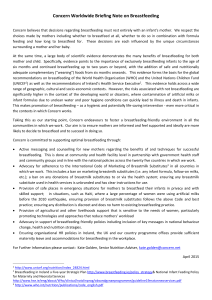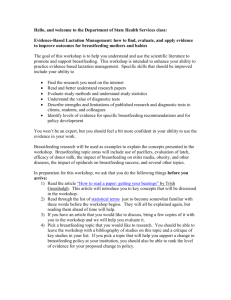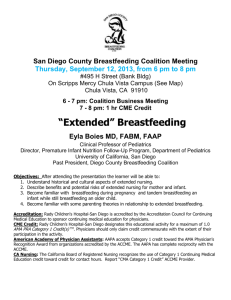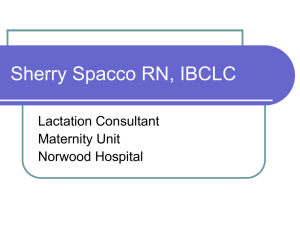Mr D Clark UNICEF
advertisement
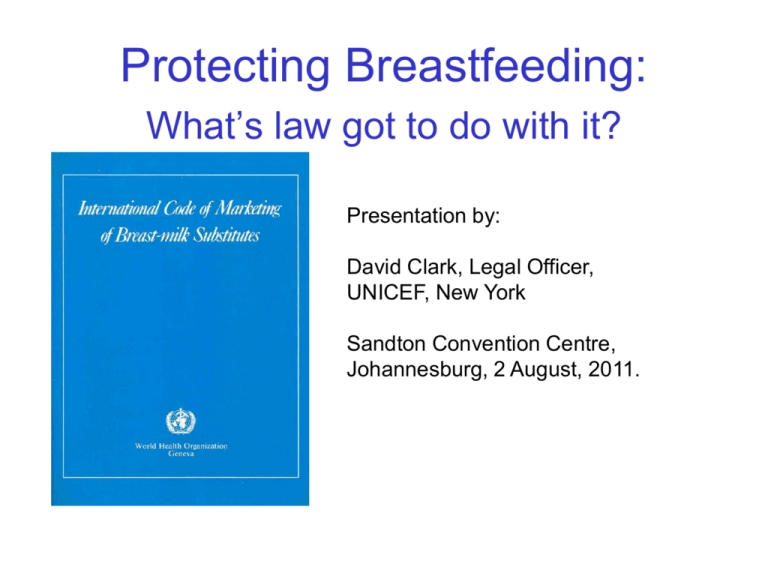
Protecting Breastfeeding: What’s law got to do with it? Presentation by: David Clark, Legal Officer, UNICEF, New York Sandton Convention Centre, Johannesburg, 2 August, 2011. What is wrong with this picture? Formula company information for mothers on importance of bonding used to undermine breastfeeding in the Caribbean. Why do we need a Code? Suboptimum breastfeeding still accounts for an estimated 1.4 million deaths in children under five annually ( Lancet 2008 Nutrition Series). The latest available data suggests only 8% of babies are exclusively breastfed at 5 months in South Africa (DHS 2003) As well as promoting and supporting breastfeeding, we need to PROTECT it from promotion of artificial feeding. Risks of not breastfeeding for all babies in all countries Increased risk of diarrhoea, gastroenteritis and tummy upsets Increased risk of diabetes Increased risk of cot death Costs more than breastfeeding Increased risk of ear infection Potentially reduced IQ score Bottle feeding affects dental occlusion Increased risk of eczema Increased risk of osteoporosis in later life Increased risk of pre-menopausal breast cancer Increased risk of ovarian cancer Breastfeeding can be a matter of life and death in industrialised countries • If 90% of US families breastfed exclusively for 6 months, the US would save $13 billion per year. • An excess of 911 deaths would be avoided (mainly infants). • $10.5 billion and 741 lives would be saved at 80% compliance). Melissa Bartick, MD, MSca, Arnold Reinhold, MBAb , The Burden of Suboptimal Breastfeeding in the United States: A Pediatric Cost Analysis, Published online April 5, 2010, PEDIATRICS (doi:10.1542/peds.2009-1616 Growing concerns: Intrinsic contamination of infant formula • Powdered infant formulas are NOT sterile products • They can become contaminated at factory level with heat resistant, pathogenic and highly contagious bacteria such as Enterobacter sakazakii WHA 58.32 (2005) Urges Member states to : Ensure information and training by health-care providers …. on the preparation, use and handling of powdered infant formula Inform that powdered infant formula may contain pathogenic microorganisms and must be prepared and used appropriately Ensure explicit warning on packaging Problem of contaminated formula not restricted to melamine scandal in China Since 2000 there have been more than 70 recalls of infant formulas, mainly in industrialised countries According to WHO: •“Generally speaking, all producers competing in the marketplace do so for two reasons: • to expand the market for a given class of product, whatever its type; and • to expand their share of the market – present and future – over that of their competitors.” •“…the marketing of infant formula presupposes a market increasing in size as more infants are fed artificially.” Source: World Health Health Development, 2001. Adapted Source: World HealthOrganization, Organization,Nutrition Nutritionfor for Healthand and Development,Geneva, Geneva,Switzerland, Switzerland,June June 2001. Adapted from the official records of the Forty-seventh World Health Assembly, document WHA47/1994/REC/1/, Annex from the official records of the Forty-seventh World Health Assembly, document WHA47/1994/REC/1/, Annex 1, 1, paragraphs 133–139. paragraphs 133–139. Corporate ambitions Achieving these goals will require clever marketing Including marketing through health workers! And companies know this….. “As breast-feeding rates are set to increase in the short term, international companies should focus on launching new products targeting breast-feeding mothers” Euromonitor International, 2008, discussing strategies for China Promotion of bms influences infant feeding behaviour Study examining relationship between advertising in a parenting magazine and breastfeeding between 1972 and 2000 found when frequency of adverts for artificial feeding increased, percentage change in breastfeeding rates decreased.1 •2006 study by the US Congressional Accountability Office found a majority of studies that examine giving free formula samples to mothers at hospital discharge found lower breastfeeding rates among mothers receiving samples.2 •1 Foss, K. and Southwell, B. International Breastfeeding Journal 2006, 1:10 •2 United States Government Accountability Office, Report to Congressional Addresees, February 2006, GAO-06-282 WHA adopted Code in 1981 to counteract negative impact of promotion of bms. “In view of the vulnerability of infants in the early months of life and the risks involved in inappropriate feeding practices, including the unnecessary and improper use of breastmilk substitutes, the marketing of breastmilk substitutes requires special treatment, which makes usual marketing practices unsuitable for these products.” Preamble to the International Code of Marketing of Breastmilk Substitutes, WHO, Geneva, 1981 What is the Code? • global recommendation - All States urged to incorporate into national legislation. • companies urged to ensure their practices comply with the Code at all levels. • Code further clarified and augmented through subsequent World Health Assembly Resolutions • Code and Resolutions form the MINIMUM STANDARD What should Governments do? Article 11.1 of the International Code “Governments should take action to give effect to the principles and aim of the Code, as appropriate to their social and legislative framework, including the adoption of national legislation, regulations or other suitable measures.” WHA 63.23 [2010] • Expressing deep concern over persistent reports of violations of the International Code by some infant food companies with regard to promotion targeting mothers and healthcare workers; • Expressing further concern over reports of the ineffectiveness of measures, particularly voluntary measures, to ensure compliance with the International Code in some countries; WHA 63.23 [2010] Urges Member States: • to develop and/or strengthen legislative, regulatory and/or other effective measures to control the marketing of breast-milk substitutes in order to give effect to the International Code …; • to end inappropriate promotion of food for infants and young children and to ensure that nutrition and health claims shall not be permitted for foods for infants and young children except where specifically provided for, in relevant Codex Alimentarius standards or national legislation; Progress in Code Implementation No of countries State of the Code by Country 1991 to 2010 Source: UNICEF 2010 Code implementation in Eastern and Southern Africa Law Botswana Madagascar Mozambique Tanzania* Uganda Zimbabwe Many provisions law Malawi Zambia Voluntary Kenya* South Africa* Swaziland Measure drafted Few provisions law Ethiopia * New drafts under preparation Burundi Namibia Rwanda Successful Code implementation prohibits the unethical marketing practices that undermine breastfeeding – and companies know it! Code implementation impacts bms sales “Government Regulation a Growing Constraint” “There are significant international variations in the regulations governing the marketing of milk formula, which are reflected in sales differences across countries.” “The industry is fighting a rearguard action against regulation on a country-by-country basis”. WHAT WORKS? Enforceable legislation ! Companies will respect the law if enforced - In response to regulatory changes in Brazil, companies changed their labels. As of 2002, labels for Isomil and Similac no longer show Rosco bear. Gerber changed its labels in Brazil and Bangladesh, which have good laws, but not elsewhere Bangladesh Malaysia Situation in South Africa • Currently classified as having a “voluntary” measures; • Work on drafting Regulations began around 2000; • Draft Regulations Relating to Foodstuffs for Infants, Young Children and Children published in the Government Gazzette 26 October 2007; • Government inundated with comments, mainly form manufacturers of BMS and their business assosciations • Draft revised in light of comments Recommended strategies: South Africa (in addition to Code and maternity protection) • Ten Steps to Successful Breastfeeding (BFHI principles) full institutionalized in ALL maternity facilities • ALL health facilities which see pregnant women and infants should have staff trained on breastfeeding counselling and support who provide these services to ALL mothers at relevant contacts • Communities (especially remote communities or those with poor access to health facilities) have access to trained lay counsellors and support (e.g. mother support groups) • Communication strategy on breastfeeding using multiple channels & based on formative research on the barriers to good breastfeeding practices Conclusions • Breastfeeding the most effective preventative public health intervention to reduce infant mortality and morbidity. • Breastfeeding saves the health care system money • Formula company promotion reduces breastfeeding and increases use of breastmilk substitutes • Implementation & enforcement of the Code prohibits unethical marketing practices that undermine breastfeeding • Code still not in place in South Africa and parents vulnerable to commercial pressures to artificially feed their babies • URGENT action needs to be taken to have the excellent draft Regulations in force.

